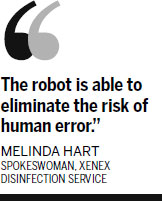Disinfectant robot employed against Ebola
The US military has enlisted a new germ-killing weapon in the fight against Ebola - a four-wheeled robot that can disinfect a room in minutes with pulses of ultraviolet light.
Resembling a taller, slimmer version of R2-D2 from Star Wars, the robots are operating at three military medical centers, and about 250 other US hospitals are using the machines to destroy pathogens.
Sending out 1.5 pulses per second in a 3-meter radius, the robots use xenon, a nontoxic gas, to create the ultraviolet rays that eradicate germs faster and more thoroughly than any human cleaning crew, doctors and officials said.
"The robot is currently part of our Ebola mitigation strategy, but will be used across the hospital to combat a variety of other pathogens known to cause hospital acquired infections," said Alton Dunham, a spokesman for Langley Air Force Base, which acquired one of the robots in October.
Although ultraviolet light has been around for decades as a tool for cleaning, the new robot uses environmentally friendly xenon instead of mercury-vapor bulbs that are slower-acting and toxic, according to Texas-based Xenex Disinfection Service, which manufactures the machines.
Hauling waste
Researchers say the disinfecting bot is just one example of how autonomous devices can play a crucial role in the fight against the Ebola outbreak in West Africa.
At a conference this month organized by the White House linking up universities across the country, scientists and aid workers concluded that robots could help haul contaminated waste or enable health workers to remotely interview patients.
The General Dynamics Land Systems MUTT, a robotic wagon, was cited as a machine already in existence that could be deployed now to help health workers in West Africa, said Robin Murphy, a professor of computer science and engineering at Texas A&M University.

"The major takeaway was that robots do exist that could be immediately repurposed now to protect Ebola health workers," Murphy said in a report on the Nov 7 brainstorming session.
But any robots sent over would have to fit into the wider medical effort, take the local culture into account and avoid imposing radical new procedures on stressed health workers, she said.
As a virus that spreads through direct human contact, Ebola demands medical equipment and methods that shield a doctor or a nurse from the risk of infection.
Like surgical masks, robots can offer a way for patients to be treated and monitored while reducing the risk of infection for the physician.
"Robots could reduce the number of times humans handle contaminated waste or the number of people needed to carry a litter," Murphy said.
But a clinic in Liberia or Sierra Leone presents challenges to robots designed in more-pristine Western settings. In addition, Wi-Fi access, ample electrical power, batteries and flat floor surfaces may not be readily available in areas where the robots are most needed.
Infections at hospitals
There are no immediate plans to send the Xenex robot to West Africa, but concern over the Ebola outbreak has underscored the wider problem of hospital-associated infections in the United States and other Western countries.
Hundreds of patients in America die every year of infections contracted during a hospital stay, including from Methicillin-resistant Staphylococcus aureus, according to government statistics.
Dozens of the hospitals that have used the Xenex robot have reported a reduction in hospital infections, according to Melinda Hart, a spokeswoman for the robot company.
The robot's ultraviolet light can disinfect surfaces and hidden areas that even the most diligent human cleaner cannot reach.
"The robot is able to eliminate the risk of human error," said Hart.
(China Daily 11/24/2014 page11)














